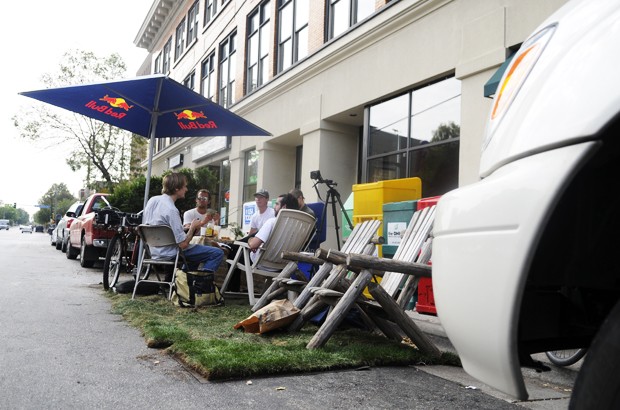On Friday afternoon, under a bright fall sun, a group of University of Minnesota students sat on a soft bed of grass, enjoying a game of cribbage and a nice cold drink at a local park. The next day their grass went back to asphalt and their park will become again a place for cars. Architecture senior Dane Steinlicht had been there since 11 a.m. with friends, laying sod in a metered parking stall outside of BreuggerâÄôs Bagels on Oak Street. The students were one of many groups across the Twin Cities taking part in an up and coming holiday known as âÄúPark(ing) Day.âÄù Park(ing) Day began four years ago in San Francisco when a group of artists decided to reclaim the urban environment through transforming street-side parking into miniature parks. The group was concerned over the fact that up to 70 percent of San FranciscoâÄôs downtown outdoor space was dedicated to accommodating cars. Since then, Park(ing) Day has grown into an international movement, celebrated every year in September. Park(ing) Day came to the Twin Cities in 2006 and has become more structured. Troy Gallas and Colin Kloecker of Solutions Twin Cities were the organizers of this yearâÄôs Park(ing) Day . Gallas and Kloecker, both 2005 graduates from the UniversityâÄôs architecture program , saw Park(ing) Day as a great opportunity. âÄúYou can transform your city with things like this,âÄù Kloecker said. While Minneapolis has many parks and an expansive skyway system, Gallas believes that the city can do more to offer truly public spaces, calling many of the public spaces in Minneapolis âÄúonly âÄòquasiâÄô public.âÄù What Park(ing) Day meant to do, according to Gallas, was simply to start a public dialogue on the uses of urban space. âÄúWe are trying to draw attention to the fact that we need more green space in the city core,âÄù he explained, âÄúplaces where people can have a good time and relax. ThatâÄôs what you do in a park.âÄù Most participants saw Park(ing) Day as a way to enjoy themselves in creative and clever ways. A lot of groups had themed parking spaces. There was a Zen Buddhism space in Dinkytown that featured a Zen garden and a 10-foot tall hanging Buddha head. Not all spectators welcomed Park(ing) Day. Some were upset about the monopolization of prime parking locations. âÄúI never can find a place to park. I think we need more parking places around here,âÄù complained Jed Booker, an audio production and engineering student at the nearby Institute of Production and Recording . A group parked in front of the Guthrie was questioned by a security guard as they were settling into their space. âÄúHe just wanted to know if we had permission to be there,âÄù said Paul Neseth of the Locus architectural firm, which had the spot. All groups received written permission from Doug Maday of Minneapolis Public Works and Transportation Services, assuring all participants that as long as they plugged the meter and didnâÄôt do anything illegal or dangerous they had every right to be there. The groups thought this yearâÄôs Park(ing) Day was a success and concluded their time outside with plans for next yearâÄôs event. Wayne Yelland , also from the Locus group, thinks that if the Twin Cities could increase participation, it could reach a critical mass after which the event would be city-wide.

Image by Chelsey Rosetter
Meters plugged to promote parks
Groups across the Twin Cities transform parking spaces into mini urban parks to celebrate Park(ing) Day.
Published September 20, 2009
0
More to Discover







